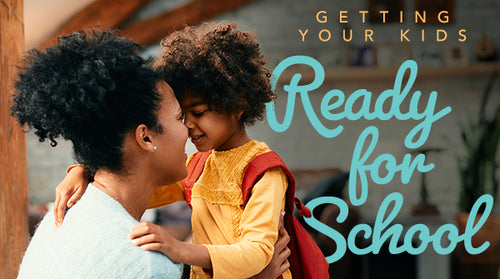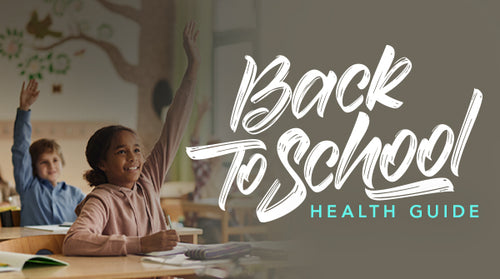All kids have scary feelings: The toddler who cries when Mommy leaves the house, the tot who worries when Daddy turns out the nursery lights.
But there are anxious feelings…and then there’s anxiety disorder.
So what’s the difference?
“When a child feels anxiety that lasts a long time and prevents them from doing things like going to school or seeing friends, then it becomes an anxiety disorder,” says the Child Mind Institute (CMI) in New York City.
“Anxiety is what drives my daughter into my room nearly every night,” says Michaela Searfoorce, mother of six. “Anxiety is why certain of my kids need to play with babysitters half a dozen times before they are left alone with them.”
Helping a child deal with anxiety is crucial; according to the American Academy of Child and Adolescent Psychiatry (AACAP), unresolved anxiety can set a child back socially and academically. Childhood anxiety may even lead to health problems in adulthood.†The information provided is not an endorsement of any product, and is intended for educational purposes only. NaturesPlus does not provide medical advice and does not offer diagnosis of any conditions. Current research on this topic is not conclusive and further research may be needed in order to prove the benefits described. The conditions and symptoms described may be indicative of serious health problems, and therefore should be brought to the attention of a qualified healthcare practitioner.
Is My Child Overly Anxious?
When we think of anxiety in children, we think of highly nervous, shy or fearful kids. But the CMI notes that “anxiety manifests in a surprising variety of ways.”
The institute gives the example of 10-year-old James, who got into a shoving match at school with another boy who had said something that upset him.
“When the teacher stepped in to break it up, James went ballistic, throwing papers and books around the classroom.” What’s more, it wasn’t the first time he had acted this way.
James seemed to be a seriously angry kid.
However, an evaluation found James to be “off the charts for social anxiety,” says CMI psychologist Jerry Bubrick, PhD. “He was terrified of being embarrassed, so when a boy said something that made him uncomfortable, James had no skills to deal with it and he freaked out.”
Children who appear to be angry may be reacting to anxiety they don’t know how to express in any other way.
The CMI adds that an anxious child can also show signs, such as not staying seated at school and asking lots of questions, that can be “easily misconstrued as ADHD.”
In addition to disruptive or angry behavior, other signs of anxiety include:
- Worry out of proportion to what’s actually happening in a child’s life; seeming constantly tense or uptight
- Physical symptoms—such as headaches, stomachaches, nausea or a racing heart—with no medical explanation
- Problems sleeping, including nightmares
- Difficulties in concentrating
- Avoiding situations, such as playing with other kids, that most children enjoy
- Clinginess (especially in younger children) or fear of being alone
- Constantly looking for reassurance
- Being excessively quiet, compliant and eager to please
- Lack of self-confidence and low self-esteem
If you see these signs, talk to your pediatrician. He or she should be able to recommend a child psychologist in your area.
Types of Childhood Anxiety
Children can suffer from a variety of anxiety disorders.
Anxiety Related to School
The types of anxiety that affect children’s lives the most are those that make going to school a challenge.
Social Anxiety
Most of the anxiety-related troubles kids experience in school are related to problems in relating to others, a condition called social anxiety.
Kids who are socially anxious “feel extremely self-conscious around other people,” says the CMI. “For a child to be diagnosed with social anxiety disorder, their worry must be so extreme that it interferes with daily life.”
Such anxiety can include what’s called social phobia, or “fear of doing something embarrassing in social settings such as classrooms, restaurants and extracurricular activities,” says the AACAP.
“These children may have difficulty answering questions in class, reading aloud, initiating conversations, talking with unfamiliar people and attending parties and social events.”
In some cases, anxious children may develop selective mutism. Kids with this condition “persistently fail to speak, read aloud or sing in specific situations (such as school) despite speaking in other situations (such as with family and in the home environment),” explains the AACAP.
Test Anxiety
Some children experience anxiety whenever they have to take tests.
“Kids with an anxious temperament who worry about making mistakes or performing in general tend to feel more test anxiety,” says the CMI.
Test anxiety may also be linked to learning issues, such as ADHD or a learning disability.
School Refusal
“My tummy hurts! I can’t go to school!” How many parents have heard a variation on that theme?
Even easygoing kids can feel a little nervous when classes start, especially if they’re attending a new school.
But children prone to anxiety “get clingier and more nervous than usual,” notes the CMI.”Having to talk a panicked first grader onto the bus or out of the car at school can be a real test of your diplomatic skills.”
“Refusal to go to school often begins following a period at home in which the child has become closer to the parent,” explains the AACAP. “It also may follow a stressful occurrence, such as the death of a pet or relative, a change in schools or a move to a new neighborhood.”
The AACAP adds, “Parents should be concerned if their child regularly complains about feeling sick or often asks to stay home from school with minor physical complaints.”
Other Types of Anxiety
In addition to school-related difficulties, children may experience other types of anxiety. These can include:
- Separation Anxiety. This often contributes to school refusal. It causes kids to “feel extremely upset when they have to be away from parents or caregivers,” says the CMI. “This anxiety goes beyond what other kids their age normally feel.”
- Generalized Anxiety. Children with this disorder “worry about a lot of everyday things,” says the CMI. “Their worry is not caused by anything specific and it is bad enough to get in the way of daily life.”
- Panic Disorder. This condition “is characterized by recurrent episodes of intense fear that occur unexpectedly,” according to the AACAP, and include physical symptoms such as shaking, difficulty breathing, chest pressure, nausea, chills or dizziness.
- Obsessive-compulsive disorder (OCD). “Children with OCD have thoughts and worries that make them very anxious,” says the CMI. “They develop rules for themselves that they feel they must follow to control the anxiety,” such as excessive hand-washing to control a fear of germs.
- Phobias. This problem causes “fear of a particular object or situation that is avoided or endured with great distress,” says the AACAP. Common phobias include fear of animals, insects, water, loud sounds or blood.
Ways to Help an Anxious Child
Fortunately, there are ways to help a child deal with worrisome feelings.
The first step is to deal with your own anxiety if necessary. In fact, it can be healthy to let your child know you both share this problem.
“It’s okay for children to see their parents cope with stress every now and then, but you want to explain why you reacted in the way that you did,” says the CMI. (What you don’t want is for your children to see you in a state of extreme distress.)
You can even work through your issues together. When you learn a specific coping strategy, for example, you can then teach it to your child.
How to Discuss Anxiety with Your Child
The idea is to help your child manage his or her feelings through self-regulation, or as the CMI puts it, “the ability to process and manage our own emotions and behaviors in a healthy way.”
Being able to regulate fear is an everyday part of adult existence; think of how you felt the last time you had to give a presentation. “But for kids, building self-regulation takes time,” says the CMI.
As a parent, you may be tempted to jump in and try to shield your child from the big, scary world. But that won’t solve the problem; you “have get comfortable with letting kids be a little uncomfortable as they figure things out,” says the CMI.
Actually, you should do everything you can to not reinforce your child’s fears.
“Let’s say a child has had a negative experience with a dog,” says Clark Goldstein, PhD, of Growth Psychology in Garden City, New York. “Next time they’re around a dog, you might be anxious about how they will respond, and you might unintentionally send a message that they should, indeed, be worried.”
Instead, Goldstein says you should encourage your child “to engage in life and to let the anxiety take its natural curve; that means that it will drop over time as he or she continues to have contact with the stressor. That’s how we get over our fears.”
That doesn’t mean telling kids to simply figure things out by themselves without your assistance.
Here are ways you can help your child overcome anxiety:
- Name what they’re feeling. “Instead of telling kids there’s nothing wrong with them, the goal is to tell them that what they’re feeling is worry,” says the CMI. Once they have a name for their feelings, they can start to connect worried feelings to signs such as a stomachache…and realize those signs are being caused by the way their bodies process scary feelings instead of by a physical illness.
- Have them talk through their fears. Goldstein says it can help a child to visualize what they would do if a fear came true: “If your mom doesn’t come at the end of soccer practice, what would you do? ‘Well I would tell the coach my mom’s not here.’ And what do you think the coach would do? ‘Well he would call my mom. Or he would wait with me.’” If your child is having a hard time verbalizing their concerns, ask questions such as “Why are you scared of (mom not arriving, dogs, the dark, etc)?”
- Use distraction (sometimes). “Feeling desperate?” asks Searfoorce. “Open (cringe) a screen and ask about ‘this game called Minecraft.’ Pull out some paint and paper. Tell a knock-knock joke. Break out the water guns.” Don’t rely on distraction as a long-term strategy…but sometimes it gives both you and your a child a break. (Besides, having fun is never a bad idea.)
- Set reasonable, positively stated goals. You can’t promise children that none of their fears will ever come true: Kids may laugh at them, they may flunk a test. “But you can express confidence that they’re going to be okay, that they will be able to manage it,” says the CMI. “Kids, especially younger ones, may need a few tries before things stick.” And instead of saying, “It’s good that you’re not so scared of dogs anymore,” accentuate the positive: “Wow, it was really brave of you to not cry when we passed that dog on the street!”
- Be patient and supportive. “Let your child know you think he can tackle his fears, even if he isn’t so sure yet,” says the CMI. “Remember that change takes time, and fear is a very powerful feeling.”
- Be patient with yourself, too. After witnessing her daughter’s first panic attack, Jen Lassalle, posting on the blog New Orleans Mom, “thought about every time I’d lost patience with her. I re-lived shouting ‘What’s wrong with you?!’ at the height of impatience one day.” Now, after therapy for both herself and her little one, “I’m thoughtful about the words I choose to correct her. I’m more compassionate towards myself.”
Teaching a Child Ways to Calm Down
Even fairly young children can be taught simple techniques for quelling anxious feelings. The CMI recommends the following:
Deep breathing. Drawing air in slowly through the nose and out through the mouth “helps kids relax by slowing breathing and reducing heart rate, blood pressure and stress hormones.” (You can find more breathing exercises here.)
Mindfulness exercises. Having children focusing on their immediate surroundings can short-circuit anxiety and “ground them in the moment.” (The site PositivePsychology.com offers these mindfulness exercises.)
Coping strategies. Children can be taught phrases such as “I can handle feeling scared” or “I’m bigger than my anxiety.” You can help your child plan how they will cope with anxious feelings in situations that bring them discomfort, such as meeting new classmates.
You can also try a subscription online service called GoZen, based on, as the site puts it, “the principle that emotional well-being can be cultivated through practice.”
Dealing with School-Related Anxiety Issues
There are specific strategies that can help a child deal with test anxiety as well as a general fear of attending school.
If your child develops physical symptoms, the CMI recommends enlisting the school’s help in keeping time spent in the nurse’s office as short as possible, before a real resistance to pushing past anxiety develops.
Helping a Child with Test Anxiety
One way to help a child do better at test time is to help him or her develop a more effective study plan beyond simply trying to remember what was said in class or reading over notes. The CMI suggests:
- Engaging more closely with the material. Have your child study class notes with an eye towards clarifying the main ideas, using outlines and timelines as necessary. “This is a more active style of studying that helps kids think about what they have been learning in a different way from how it was presented, which will give them a richer understanding of it,” the CMI says.
- Knowing the test format. Will it be multiple choice, true or false, an essay or some combination? Knowing ahead of time can help your child feel more prepared.
- Thinking about possible questions. For instance, if you know the test will contain an essay, have your child try to think about what topics might be covered and practice writing answers ahead of time.
- Having a plan for test day. The idea is to avoid getting stuck—and then panicking as time grows short. Have your child not spend too much time on any one question by either picking an answer and sticking with it or by accepting that he or she doesn’t know the answer and moving on. One way to change focus: Turning to the last page and answering the last question first.
Helping a Child Who Doesn’t Want to Go to School
“The most important thing a parent can do when kids resist going is to continue sending them to school anyway,” says the CMI.
It’s not a bad idea to let the school know that your child may need help getting over first-day jitters.
The CMI even advises taking some test runs: “Go to the school several times before school starts, and do as much walking the halls as you can, to locate their classroom, the lavatory, the cafeteria the playground. If you can, introduce them to their teacher.”
For a child with separation anxiety, you may be able to arrange a handoff via an aide, school nurse or someone else. Have that person ask your child for assistance with a minor task—”Can you help me bring these blocks to the bin?”—as a diversion while you leave the building.
However, “if a child’s resistance to school is overwhelming and prolonged, they should be evaluated by a mental health professional,” advises the CMI. “It’s good to proactive rather than waiting months for it to pass.”
Other indications that your child may need professional help is obsessive worrying and fears that limit his or her ability to enjoy life, such as avoiding visits to the park for fear dogs may be there.
Therapies for Anxious Children
There are a number of approaches to treating childhood anxiety. In addition to medications, the two main ones are:
- Family therapy. Sometimes there’s a family dynamic that needs to be addressed before a child can successfully deal with anxiety. The AACAP says this may include “interventions that improve parent-child relationships, strengthen family problem solving, reduce parental anxiety and foster parenting skills.”
- Cognitive behavioral therapy (CBT). “CBT is based on the idea that how we think and act both affect how we feel,” says the CMI. “By learning to change negative thoughts and unhealthy actions, kids can change their bad feelings.” We all make thinking mistakes, such as blaming yourself for things beyond your control or seeing only the worst possible outcome in a situation; CBT offers a way to help correct those mistakes.
†The information provided is not an endorsement of any product, and is intended for educational purposes only. NaturesPlus does not provide medical advice and does not offer diagnosis of any conditions. Current research on this topic is not conclusive and further research may be needed in order to prove the benefits described. The conditions and symptoms described may be indicative of serious health problems, and therefore should be brought to the attention of a qualified healthcare practitioner.The information provided is not an endorsement of any product, and is intended for educational purposes only. NaturesPlus does not provide medical advice and does not offer diagnosis of any conditions. Current research on this topic is not conclusive and further research may be needed in order to prove the benefits described.
The conditions and symptoms described may be indicative of serious health problems, and therefore should be brought to the attention of a qualified healthcare practitioner.
Like this article? You’ll love our weekly newsletter
sign up here!
**These statements have not been evaluated by the Food and Drug Administration. This product is not intended to diagnose, treat, cure or prevent any disease.









































































